MAN6302: Project Management - Quality Issues Analysis Report
VerifiedAdded on 2022/08/22
|7
|1931
|14
Report
AI Summary
This report delves into the core principles of project management, emphasizing the critical aspects of quality management and the Project Management Body of Knowledge (PMBOK) framework. It explores the fundamental concepts of project initiation, planning, execution, controlling, and closing, highlighting their significance in achieving project objectives and success criteria. The report discusses the role of PMBOK in standardizing project management practices, emphasizing its value in providing a structured approach for managing projects, especially regarding risk management and resource training. The report further examines project quality issues, including quality assurance and control, and the application of tools such as the PDCA cycle to ensure that projects meet stakeholder expectations and deliver desired outcomes. The analysis includes various references to key research and publications in the field, such as those by Kerzner, Fleming & Koppelman, Marchewka, and Martens & Carvalho, providing a comprehensive overview of project management best practices and challenges.
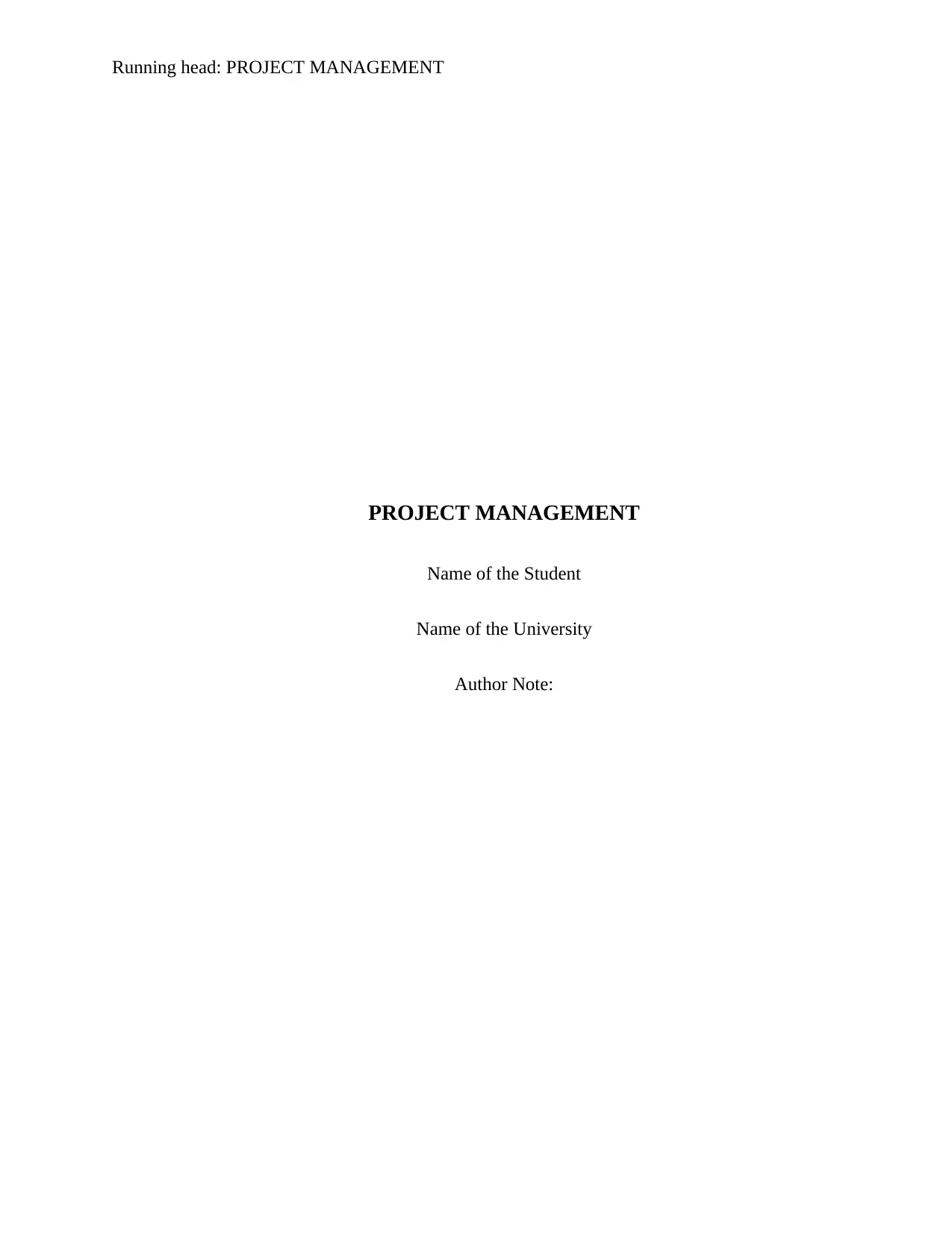
Running head: PROJECT MANAGEMENT
PROJECT MANAGEMENT
Name of the Student
Name of the University
Author Note:
PROJECT MANAGEMENT
Name of the Student
Name of the University
Author Note:
Paraphrase This Document
Need a fresh take? Get an instant paraphrase of this document with our AI Paraphraser
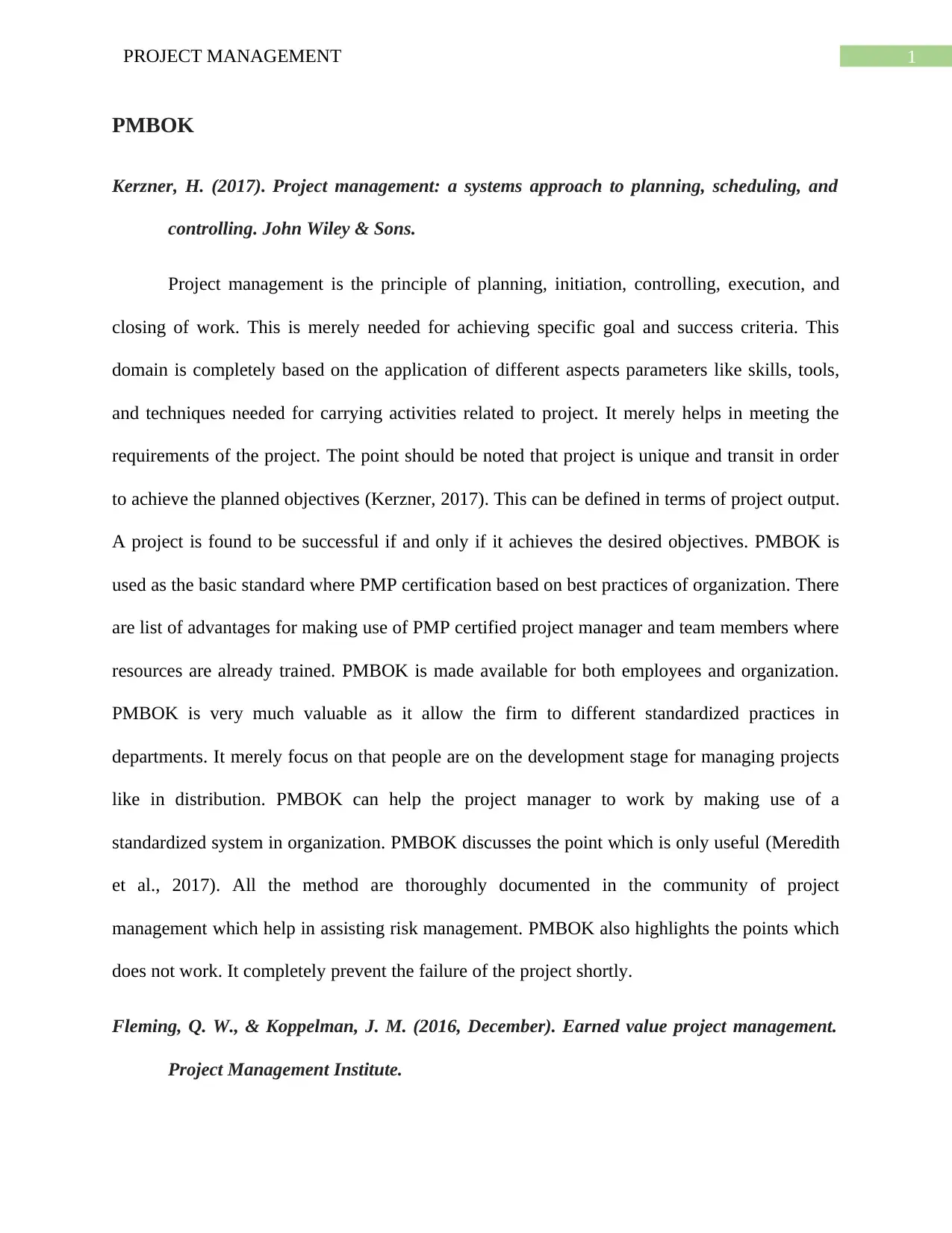
1PROJECT MANAGEMENT
PMBOK
Kerzner, H. (2017). Project management: a systems approach to planning, scheduling, and
controlling. John Wiley & Sons.
Project management is the principle of planning, initiation, controlling, execution, and
closing of work. This is merely needed for achieving specific goal and success criteria. This
domain is completely based on the application of different aspects parameters like skills, tools,
and techniques needed for carrying activities related to project. It merely helps in meeting the
requirements of the project. The point should be noted that project is unique and transit in order
to achieve the planned objectives (Kerzner, 2017). This can be defined in terms of project output.
A project is found to be successful if and only if it achieves the desired objectives. PMBOK is
used as the basic standard where PMP certification based on best practices of organization. There
are list of advantages for making use of PMP certified project manager and team members where
resources are already trained. PMBOK is made available for both employees and organization.
PMBOK is very much valuable as it allow the firm to different standardized practices in
departments. It merely focus on that people are on the development stage for managing projects
like in distribution. PMBOK can help the project manager to work by making use of a
standardized system in organization. PMBOK discusses the point which is only useful (Meredith
et al., 2017). All the method are thoroughly documented in the community of project
management which help in assisting risk management. PMBOK also highlights the points which
does not work. It completely prevent the failure of the project shortly.
Fleming, Q. W., & Koppelman, J. M. (2016, December). Earned value project management.
Project Management Institute.
PMBOK
Kerzner, H. (2017). Project management: a systems approach to planning, scheduling, and
controlling. John Wiley & Sons.
Project management is the principle of planning, initiation, controlling, execution, and
closing of work. This is merely needed for achieving specific goal and success criteria. This
domain is completely based on the application of different aspects parameters like skills, tools,
and techniques needed for carrying activities related to project. It merely helps in meeting the
requirements of the project. The point should be noted that project is unique and transit in order
to achieve the planned objectives (Kerzner, 2017). This can be defined in terms of project output.
A project is found to be successful if and only if it achieves the desired objectives. PMBOK is
used as the basic standard where PMP certification based on best practices of organization. There
are list of advantages for making use of PMP certified project manager and team members where
resources are already trained. PMBOK is made available for both employees and organization.
PMBOK is very much valuable as it allow the firm to different standardized practices in
departments. It merely focus on that people are on the development stage for managing projects
like in distribution. PMBOK can help the project manager to work by making use of a
standardized system in organization. PMBOK discusses the point which is only useful (Meredith
et al., 2017). All the method are thoroughly documented in the community of project
management which help in assisting risk management. PMBOK also highlights the points which
does not work. It completely prevent the failure of the project shortly.
Fleming, Q. W., & Koppelman, J. M. (2016, December). Earned value project management.
Project Management Institute.
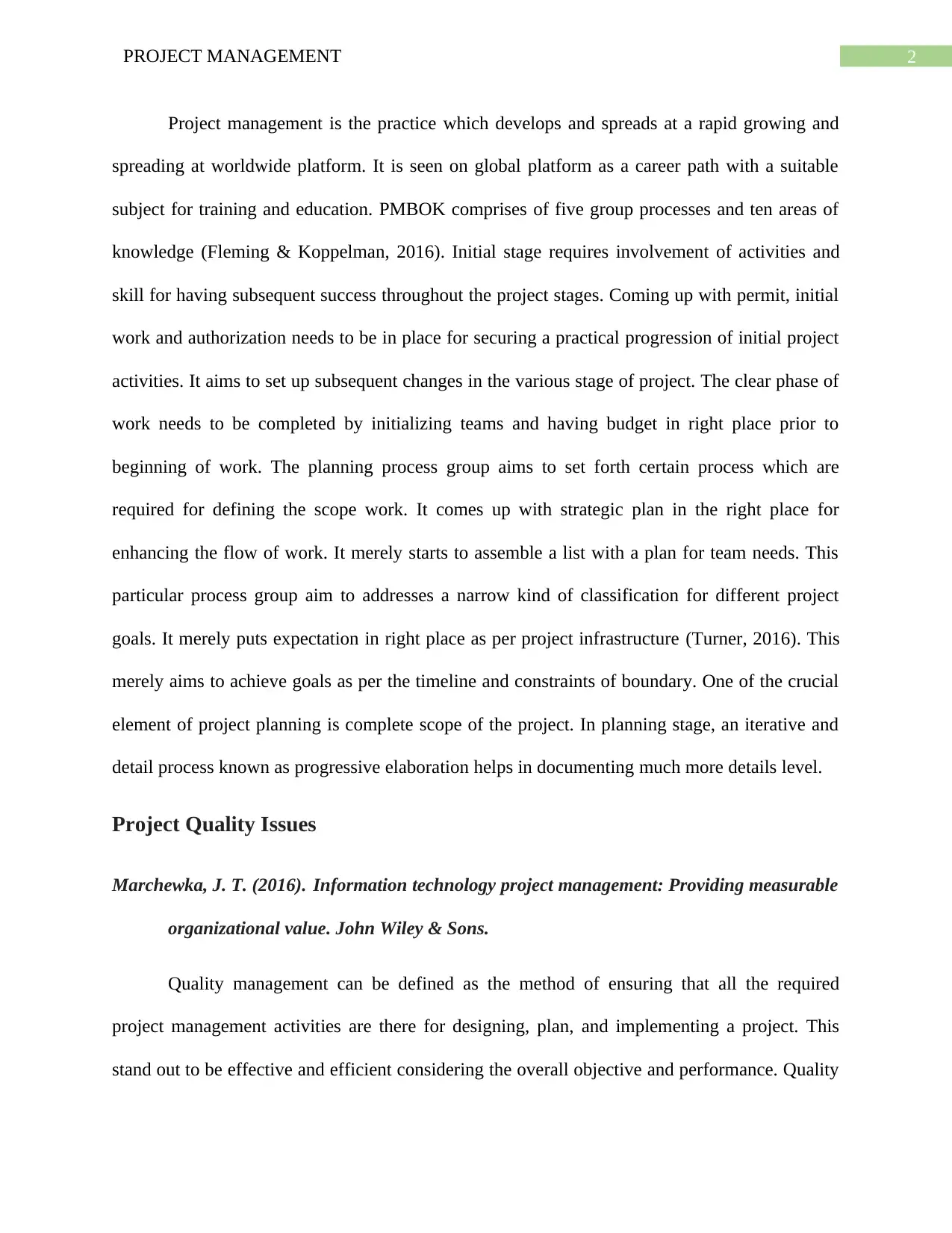
2PROJECT MANAGEMENT
Project management is the practice which develops and spreads at a rapid growing and
spreading at worldwide platform. It is seen on global platform as a career path with a suitable
subject for training and education. PMBOK comprises of five group processes and ten areas of
knowledge (Fleming & Koppelman, 2016). Initial stage requires involvement of activities and
skill for having subsequent success throughout the project stages. Coming up with permit, initial
work and authorization needs to be in place for securing a practical progression of initial project
activities. It aims to set up subsequent changes in the various stage of project. The clear phase of
work needs to be completed by initializing teams and having budget in right place prior to
beginning of work. The planning process group aims to set forth certain process which are
required for defining the scope work. It comes up with strategic plan in the right place for
enhancing the flow of work. It merely starts to assemble a list with a plan for team needs. This
particular process group aim to addresses a narrow kind of classification for different project
goals. It merely puts expectation in right place as per project infrastructure (Turner, 2016). This
merely aims to achieve goals as per the timeline and constraints of boundary. One of the crucial
element of project planning is complete scope of the project. In planning stage, an iterative and
detail process known as progressive elaboration helps in documenting much more details level.
Project Quality Issues
Marchewka, J. T. (2016). Information technology project management: Providing measurable
organizational value. John Wiley & Sons.
Quality management can be defined as the method of ensuring that all the required
project management activities are there for designing, plan, and implementing a project. This
stand out to be effective and efficient considering the overall objective and performance. Quality
Project management is the practice which develops and spreads at a rapid growing and
spreading at worldwide platform. It is seen on global platform as a career path with a suitable
subject for training and education. PMBOK comprises of five group processes and ten areas of
knowledge (Fleming & Koppelman, 2016). Initial stage requires involvement of activities and
skill for having subsequent success throughout the project stages. Coming up with permit, initial
work and authorization needs to be in place for securing a practical progression of initial project
activities. It aims to set up subsequent changes in the various stage of project. The clear phase of
work needs to be completed by initializing teams and having budget in right place prior to
beginning of work. The planning process group aims to set forth certain process which are
required for defining the scope work. It comes up with strategic plan in the right place for
enhancing the flow of work. It merely starts to assemble a list with a plan for team needs. This
particular process group aim to addresses a narrow kind of classification for different project
goals. It merely puts expectation in right place as per project infrastructure (Turner, 2016). This
merely aims to achieve goals as per the timeline and constraints of boundary. One of the crucial
element of project planning is complete scope of the project. In planning stage, an iterative and
detail process known as progressive elaboration helps in documenting much more details level.
Project Quality Issues
Marchewka, J. T. (2016). Information technology project management: Providing measurable
organizational value. John Wiley & Sons.
Quality management can be defined as the method of ensuring that all the required
project management activities are there for designing, plan, and implementing a project. This
stand out to be effective and efficient considering the overall objective and performance. Quality
⊘ This is a preview!⊘
Do you want full access?
Subscribe today to unlock all pages.

Trusted by 1+ million students worldwide
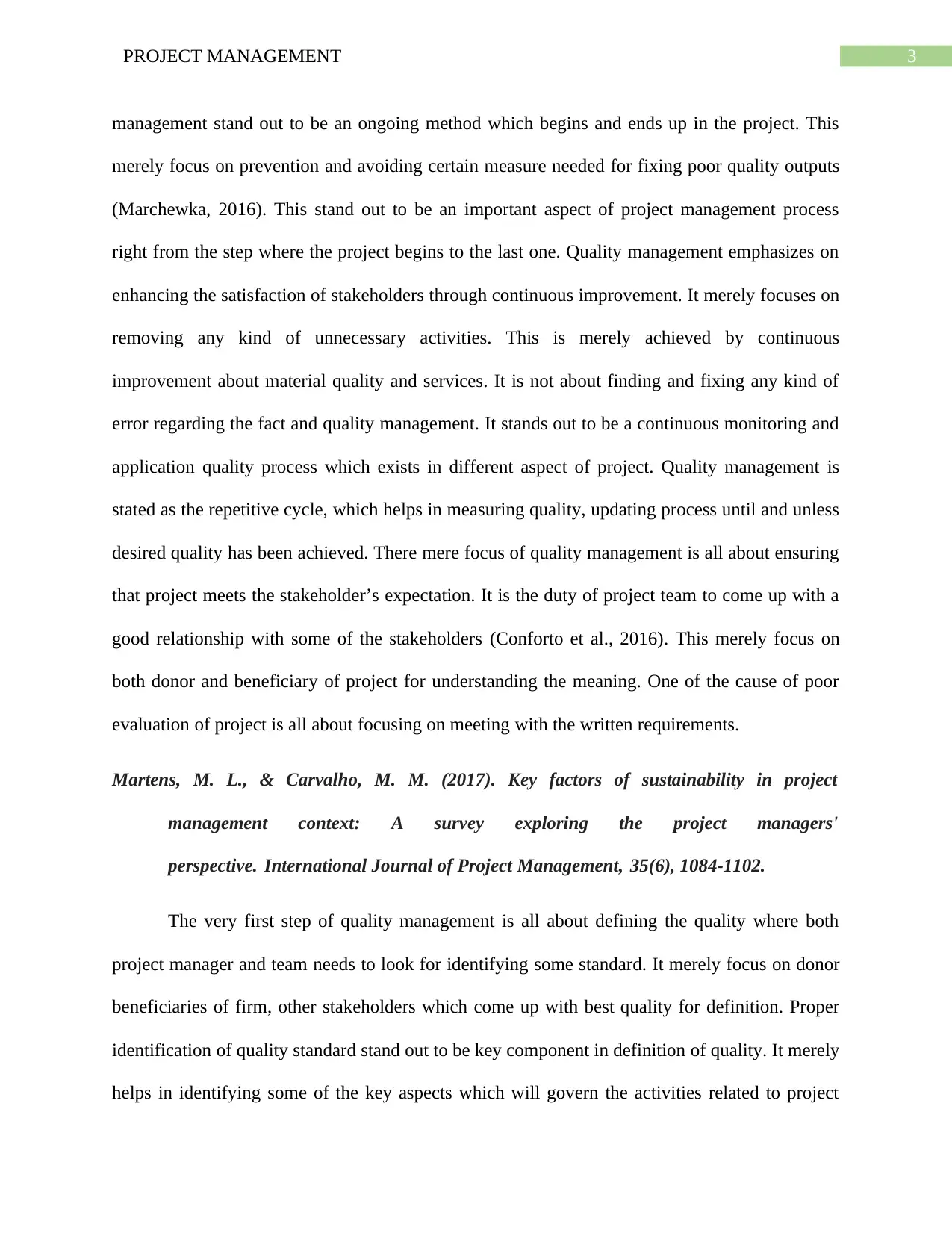
3PROJECT MANAGEMENT
management stand out to be an ongoing method which begins and ends up in the project. This
merely focus on prevention and avoiding certain measure needed for fixing poor quality outputs
(Marchewka, 2016). This stand out to be an important aspect of project management process
right from the step where the project begins to the last one. Quality management emphasizes on
enhancing the satisfaction of stakeholders through continuous improvement. It merely focuses on
removing any kind of unnecessary activities. This is merely achieved by continuous
improvement about material quality and services. It is not about finding and fixing any kind of
error regarding the fact and quality management. It stands out to be a continuous monitoring and
application quality process which exists in different aspect of project. Quality management is
stated as the repetitive cycle, which helps in measuring quality, updating process until and unless
desired quality has been achieved. There mere focus of quality management is all about ensuring
that project meets the stakeholder’s expectation. It is the duty of project team to come up with a
good relationship with some of the stakeholders (Conforto et al., 2016). This merely focus on
both donor and beneficiary of project for understanding the meaning. One of the cause of poor
evaluation of project is all about focusing on meeting with the written requirements.
Martens, M. L., & Carvalho, M. M. (2017). Key factors of sustainability in project
management context: A survey exploring the project managers'
perspective. International Journal of Project Management, 35(6), 1084-1102.
The very first step of quality management is all about defining the quality where both
project manager and team needs to look for identifying some standard. It merely focus on donor
beneficiaries of firm, other stakeholders which come up with best quality for definition. Proper
identification of quality standard stand out to be key component in definition of quality. It merely
helps in identifying some of the key aspects which will govern the activities related to project
management stand out to be an ongoing method which begins and ends up in the project. This
merely focus on prevention and avoiding certain measure needed for fixing poor quality outputs
(Marchewka, 2016). This stand out to be an important aspect of project management process
right from the step where the project begins to the last one. Quality management emphasizes on
enhancing the satisfaction of stakeholders through continuous improvement. It merely focuses on
removing any kind of unnecessary activities. This is merely achieved by continuous
improvement about material quality and services. It is not about finding and fixing any kind of
error regarding the fact and quality management. It stands out to be a continuous monitoring and
application quality process which exists in different aspect of project. Quality management is
stated as the repetitive cycle, which helps in measuring quality, updating process until and unless
desired quality has been achieved. There mere focus of quality management is all about ensuring
that project meets the stakeholder’s expectation. It is the duty of project team to come up with a
good relationship with some of the stakeholders (Conforto et al., 2016). This merely focus on
both donor and beneficiary of project for understanding the meaning. One of the cause of poor
evaluation of project is all about focusing on meeting with the written requirements.
Martens, M. L., & Carvalho, M. M. (2017). Key factors of sustainability in project
management context: A survey exploring the project managers'
perspective. International Journal of Project Management, 35(6), 1084-1102.
The very first step of quality management is all about defining the quality where both
project manager and team needs to look for identifying some standard. It merely focus on donor
beneficiaries of firm, other stakeholders which come up with best quality for definition. Proper
identification of quality standard stand out to be key component in definition of quality. It merely
helps in identifying some of the key aspects which will govern the activities related to project
Paraphrase This Document
Need a fresh take? Get an instant paraphrase of this document with our AI Paraphraser
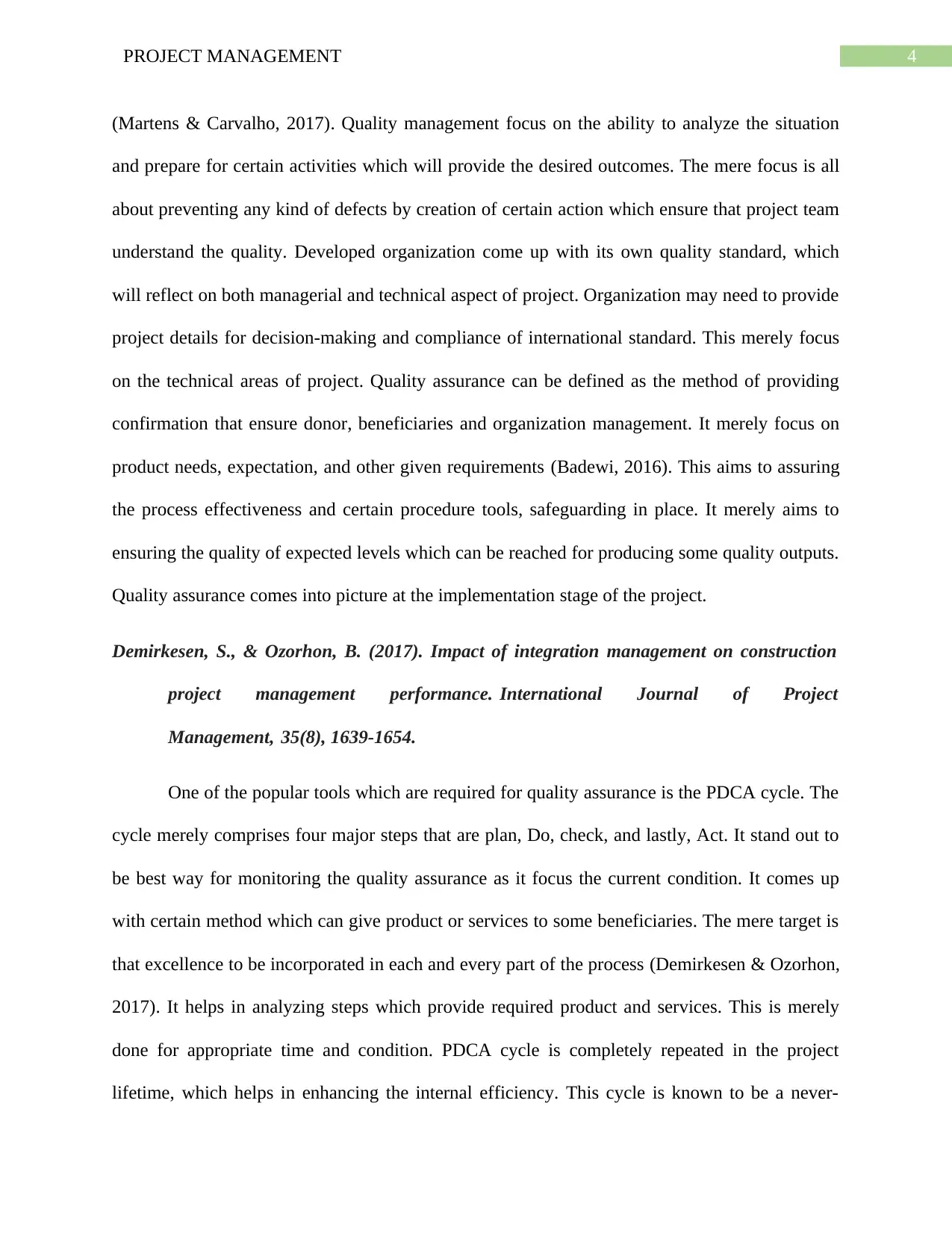
4PROJECT MANAGEMENT
(Martens & Carvalho, 2017). Quality management focus on the ability to analyze the situation
and prepare for certain activities which will provide the desired outcomes. The mere focus is all
about preventing any kind of defects by creation of certain action which ensure that project team
understand the quality. Developed organization come up with its own quality standard, which
will reflect on both managerial and technical aspect of project. Organization may need to provide
project details for decision-making and compliance of international standard. This merely focus
on the technical areas of project. Quality assurance can be defined as the method of providing
confirmation that ensure donor, beneficiaries and organization management. It merely focus on
product needs, expectation, and other given requirements (Badewi, 2016). This aims to assuring
the process effectiveness and certain procedure tools, safeguarding in place. It merely aims to
ensuring the quality of expected levels which can be reached for producing some quality outputs.
Quality assurance comes into picture at the implementation stage of the project.
Demirkesen, S., & Ozorhon, B. (2017). Impact of integration management on construction
project management performance. International Journal of Project
Management, 35(8), 1639-1654.
One of the popular tools which are required for quality assurance is the PDCA cycle. The
cycle merely comprises four major steps that are plan, Do, check, and lastly, Act. It stand out to
be best way for monitoring the quality assurance as it focus the current condition. It comes up
with certain method which can give product or services to some beneficiaries. The mere target is
that excellence to be incorporated in each and every part of the process (Demirkesen & Ozorhon,
2017). It helps in analyzing steps which provide required product and services. This is merely
done for appropriate time and condition. PDCA cycle is completely repeated in the project
lifetime, which helps in enhancing the internal efficiency. This cycle is known to be a never-
(Martens & Carvalho, 2017). Quality management focus on the ability to analyze the situation
and prepare for certain activities which will provide the desired outcomes. The mere focus is all
about preventing any kind of defects by creation of certain action which ensure that project team
understand the quality. Developed organization come up with its own quality standard, which
will reflect on both managerial and technical aspect of project. Organization may need to provide
project details for decision-making and compliance of international standard. This merely focus
on the technical areas of project. Quality assurance can be defined as the method of providing
confirmation that ensure donor, beneficiaries and organization management. It merely focus on
product needs, expectation, and other given requirements (Badewi, 2016). This aims to assuring
the process effectiveness and certain procedure tools, safeguarding in place. It merely aims to
ensuring the quality of expected levels which can be reached for producing some quality outputs.
Quality assurance comes into picture at the implementation stage of the project.
Demirkesen, S., & Ozorhon, B. (2017). Impact of integration management on construction
project management performance. International Journal of Project
Management, 35(8), 1639-1654.
One of the popular tools which are required for quality assurance is the PDCA cycle. The
cycle merely comprises four major steps that are plan, Do, check, and lastly, Act. It stand out to
be best way for monitoring the quality assurance as it focus the current condition. It comes up
with certain method which can give product or services to some beneficiaries. The mere target is
that excellence to be incorporated in each and every part of the process (Demirkesen & Ozorhon,
2017). It helps in analyzing steps which provide required product and services. This is merely
done for appropriate time and condition. PDCA cycle is completely repeated in the project
lifetime, which helps in enhancing the internal efficiency. This cycle is known to be a never-
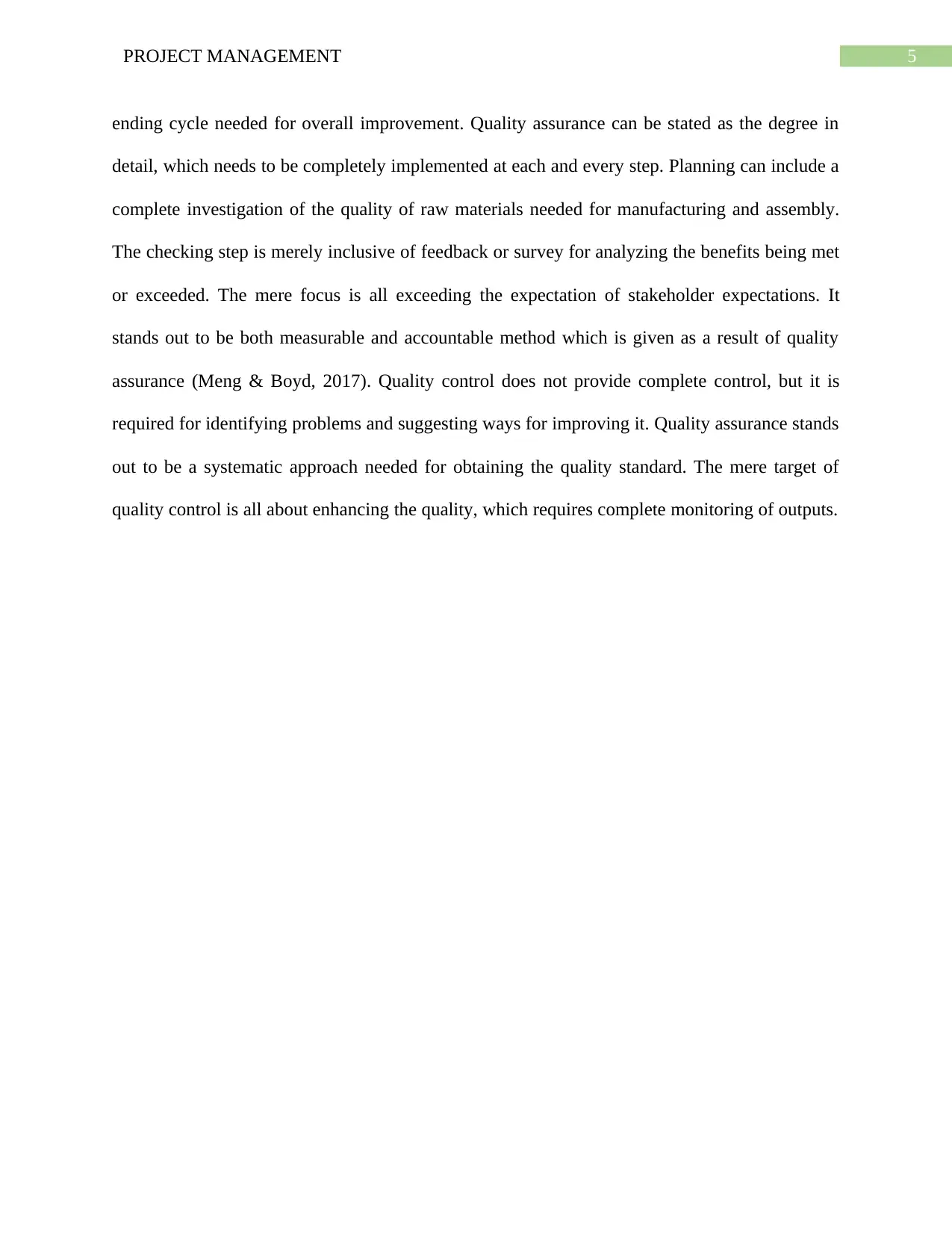
5PROJECT MANAGEMENT
ending cycle needed for overall improvement. Quality assurance can be stated as the degree in
detail, which needs to be completely implemented at each and every step. Planning can include a
complete investigation of the quality of raw materials needed for manufacturing and assembly.
The checking step is merely inclusive of feedback or survey for analyzing the benefits being met
or exceeded. The mere focus is all exceeding the expectation of stakeholder expectations. It
stands out to be both measurable and accountable method which is given as a result of quality
assurance (Meng & Boyd, 2017). Quality control does not provide complete control, but it is
required for identifying problems and suggesting ways for improving it. Quality assurance stands
out to be a systematic approach needed for obtaining the quality standard. The mere target of
quality control is all about enhancing the quality, which requires complete monitoring of outputs.
ending cycle needed for overall improvement. Quality assurance can be stated as the degree in
detail, which needs to be completely implemented at each and every step. Planning can include a
complete investigation of the quality of raw materials needed for manufacturing and assembly.
The checking step is merely inclusive of feedback or survey for analyzing the benefits being met
or exceeded. The mere focus is all exceeding the expectation of stakeholder expectations. It
stands out to be both measurable and accountable method which is given as a result of quality
assurance (Meng & Boyd, 2017). Quality control does not provide complete control, but it is
required for identifying problems and suggesting ways for improving it. Quality assurance stands
out to be a systematic approach needed for obtaining the quality standard. The mere target of
quality control is all about enhancing the quality, which requires complete monitoring of outputs.
⊘ This is a preview!⊘
Do you want full access?
Subscribe today to unlock all pages.

Trusted by 1+ million students worldwide
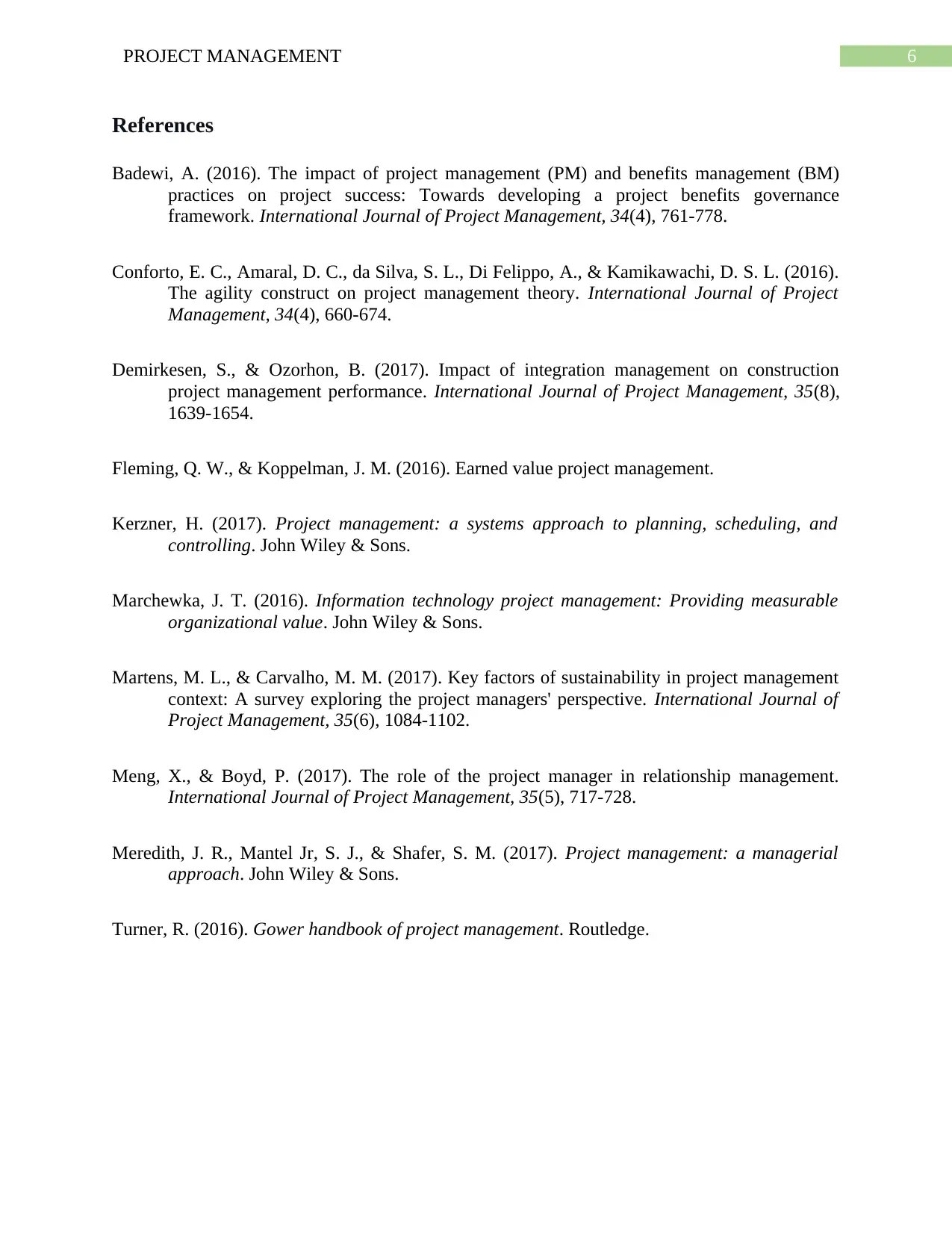
6PROJECT MANAGEMENT
References
Badewi, A. (2016). The impact of project management (PM) and benefits management (BM)
practices on project success: Towards developing a project benefits governance
framework. International Journal of Project Management, 34(4), 761-778.
Conforto, E. C., Amaral, D. C., da Silva, S. L., Di Felippo, A., & Kamikawachi, D. S. L. (2016).
The agility construct on project management theory. International Journal of Project
Management, 34(4), 660-674.
Demirkesen, S., & Ozorhon, B. (2017). Impact of integration management on construction
project management performance. International Journal of Project Management, 35(8),
1639-1654.
Fleming, Q. W., & Koppelman, J. M. (2016). Earned value project management.
Kerzner, H. (2017). Project management: a systems approach to planning, scheduling, and
controlling. John Wiley & Sons.
Marchewka, J. T. (2016). Information technology project management: Providing measurable
organizational value. John Wiley & Sons.
Martens, M. L., & Carvalho, M. M. (2017). Key factors of sustainability in project management
context: A survey exploring the project managers' perspective. International Journal of
Project Management, 35(6), 1084-1102.
Meng, X., & Boyd, P. (2017). The role of the project manager in relationship management.
International Journal of Project Management, 35(5), 717-728.
Meredith, J. R., Mantel Jr, S. J., & Shafer, S. M. (2017). Project management: a managerial
approach. John Wiley & Sons.
Turner, R. (2016). Gower handbook of project management. Routledge.
References
Badewi, A. (2016). The impact of project management (PM) and benefits management (BM)
practices on project success: Towards developing a project benefits governance
framework. International Journal of Project Management, 34(4), 761-778.
Conforto, E. C., Amaral, D. C., da Silva, S. L., Di Felippo, A., & Kamikawachi, D. S. L. (2016).
The agility construct on project management theory. International Journal of Project
Management, 34(4), 660-674.
Demirkesen, S., & Ozorhon, B. (2017). Impact of integration management on construction
project management performance. International Journal of Project Management, 35(8),
1639-1654.
Fleming, Q. W., & Koppelman, J. M. (2016). Earned value project management.
Kerzner, H. (2017). Project management: a systems approach to planning, scheduling, and
controlling. John Wiley & Sons.
Marchewka, J. T. (2016). Information technology project management: Providing measurable
organizational value. John Wiley & Sons.
Martens, M. L., & Carvalho, M. M. (2017). Key factors of sustainability in project management
context: A survey exploring the project managers' perspective. International Journal of
Project Management, 35(6), 1084-1102.
Meng, X., & Boyd, P. (2017). The role of the project manager in relationship management.
International Journal of Project Management, 35(5), 717-728.
Meredith, J. R., Mantel Jr, S. J., & Shafer, S. M. (2017). Project management: a managerial
approach. John Wiley & Sons.
Turner, R. (2016). Gower handbook of project management. Routledge.
1 out of 7
Related Documents
Your All-in-One AI-Powered Toolkit for Academic Success.
+13062052269
info@desklib.com
Available 24*7 on WhatsApp / Email
![[object Object]](/_next/static/media/star-bottom.7253800d.svg)
Unlock your academic potential
Copyright © 2020–2025 A2Z Services. All Rights Reserved. Developed and managed by ZUCOL.



